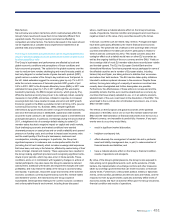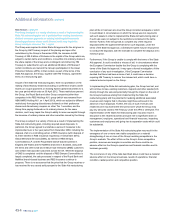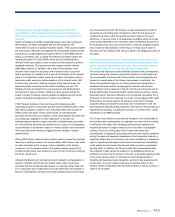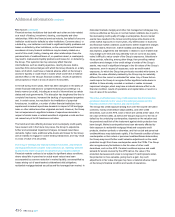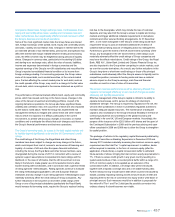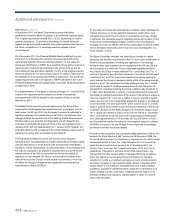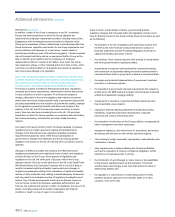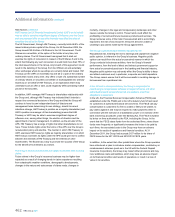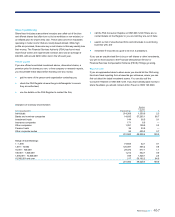RBS 2011 Annual Report Download - page 461
Download and view the complete annual report
Please find page 461 of the 2011 RBS annual report below. You can navigate through the pages in the report by either clicking on the pages listed below, or by using the keyword search tool below to find specific information within the annual report.
RBS Group 2011 459
The Group is and may be subject to litigation and regulatory
investigations that may have a material impact on its business
The Group’s operations are diverse and complex and it operates in legal
and regulatory environments that expose it to potentially significant
litigation, regulatory investigation and other regulatory risk. As a result,
the Group is, and may in the future be, involved in various disputes, legal
proceedings and regulatory investigations in the UK, the EU, the US and
other jurisdictions, including class action litigation, LIBOR related litigation
and investigations and anti-money laundering, sanctions and compliance
related investigations. The Group may also incur the risk of civil suits,
criminal liability or regulatory actions as a result of its disclosure
obligations to HM Treasury under the APS. In addition, the Group, like
many other financial institutions, has come under greater regulatory
scrutiny in recent years and expects that environment to continue for the
foreseeable future, particularly as it relates to compliance with new and
existing corporate governance, employee compensation, conduct of
business, anti-money laundering and anti-terrorism laws and regulations,
as well as the provisions of applicable sanctions programmes. Disputes,
legal proceedings and regulatory investigations are subject to many
uncertainties, and their outcomes are often difficult to predict, particularly
in the early stages of a case or investigation. Adverse regulatory action or
adverse judgments in litigation could result in restrictions or limitations on
the Group’s operations or have a significant effect on the Group’s
reputation or results of operations or result in a loss of value of its
securities.
The value of certain financial instruments recorded at fair value is
determined using financial models incorporating assumptions,
judgements and estimates that may change over time or may ultimately
not turn out to be accurate
Under International Financial Reporting Standards (IFRS), the Group
recognises at fair value: (i) financial instruments classified as held-for-
trading or designated as at fair value through profit or loss; (ii) financial
assets classified as available-for-sale; and (iii) derivatives. Generally, to
establish the fair value of these instruments, the Group relies on quoted
market prices or, where the market for a financial instrument is not
sufficiently active, internal valuation models that utilise observable market
data. In certain circumstances, the data for individual financial
instruments or classes of financial instruments utilised by such valuation
models may not be available or may become unavailable due to
prevailing market conditions. In such circumstances, the Group’s internal
valuation models require the Group to make assumptions, judgements
and estimates to establish fair value, which are complex and often relate
to matters that are inherently uncertain. These assumptions, judgements
and estimates will need to be updated to reflect changing facts, trends
and market conditions. The resulting change in the fair values of the
financial instruments has had and could continue to have a material
adverse effect on the Group’s earnings and financial condition or result in
aloss of value of its securities.
The Group operates in markets that are highly competitive and its
business and results of operations may be adversely affected
The competitive landscape for banks and other financial institutions in the
UK, the US and throughout the rest of Europe is subject to rapid change
and recent regulatory and legal changes are likely to result in new market
participants and changed competitive dynamics in certain key areas,
such as in retail banking in the UK. The competitive landscape in the UK
will be particularly influenced by the recommendations on competition
included in the ICB’s final report, and the UK Government’s
implementation of the recommendations, as discussed above. In order to
compete effectively, certain financial institutions may seek to consolidate
their businesses or assets with other parties. This consolidation, in
combination with the introduction of new entrants into the markets in
which the Group operates, is likely to increase competitive pressures on
the Group.
In addition, certain competitors may have access to lower cost funding
and/or be able to attract deposits on more favourable terms than the
Group and may have stronger and more efficient operations.
Furthermore, the Group’s competitors may be better able to attract and
retain clients and key employees, which may have a negative impact on
the Group’s relative performance and future prospects. In addition, future
disposals and restructurings by the Group and the compensation
structure and restrictions imposed on the Group may also have an impact
on its ability to compete effectively. These and other changes to the
competitive landscape could adversely affect the Group’s business,
margins, profitability, financial condition and prospects or result in a loss
of value of its securities.
The Group could fail to attract or retain senior management, which may
include members of the Board, or other key employees, and it may suffer
if it does not maintain good employee relations
The Group’s ability to implement its strategy and its future success
depends on its ability to attract, retain and remunerate highly skilled and
qualified personnel, including its senior management, which include
directors and other key employees, competitively with its peers. This
cannot be guaranteed, particularly in light of heightened regulatory
oversight of banks and heightened scrutiny of, and (in some cases)
restrictions placed upon, management and employee compensation
arrangements, in particular those in receipt of Government support (such
as the Group).
In addition to the effects of such measures on the Group’s ability to retain
senior management and other key employees, the marketplace for skilled
personnel is becoming more competitive, which means the cost of hiring,
training and retaining skilled personnel may continue to increase. The
failure to attract or retain a sufficient number of appropriately skilled
personnel could place the Group at a significant competitive
disadvantage and prevent the Group from successfully implementing its
strategy, which could have a material adverse effect on the Group’s
financial condition and results of operations or result in a loss of value of
its securities.




